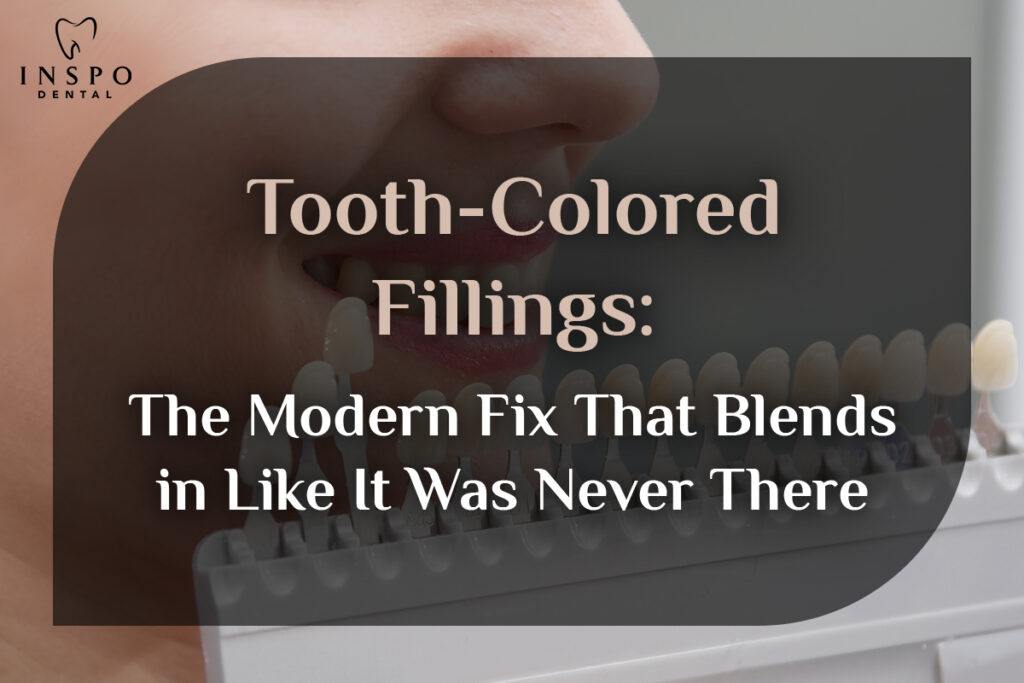🎨 What Are Tooth-Colored Fillings?
Tooth-colored fillings, also known as composite fillings, are dental restorations made from a mixture of plastic resins and finely ground glass-like particles. They are designed to match the natural shade of your teeth, offering both functionality and aesthetics in one seamless solution. Unlike traditional silver (amalgam) fillings, composite fillings are virtually invisible when applied correctly.
These modern restorations have grown in popularity among patients who value both oral health and a natural-looking smile. Whether it’s a small cavity or a cosmetic repair, tooth-colored fillings are quickly becoming the preferred choice in 2026.
🦷 Why More Patients Are Choosing Tooth-Colored Fillings in 2026
As dental technology continues to evolve, so do patient expectations. Here’s why tooth-colored fillings are dominating the conversation today:
✅ Natural Appearance
Composite fillings are meticulously color-matched to your natural tooth enamel, making them ideal for visible areas like front teeth.
✅ Mercury-Free Alternative
Unlike amalgam fillings that contain mercury, composite resins are entirely mercury-free and considered more biocompatible.
✅ Minimally Invasive
Tooth-colored fillings bond directly to the tooth structure, often requiring less drilling and conserving more of your natural tooth.
✅ Strong and Durable
Modern composite materials are engineered to withstand everyday chewing forces, especially when used in small to mid-sized cavities.
✅ Quick, Single-Visit Procedure
Most tooth-colored fillings can be completed in one visit, offering convenience for busy lifestyles.
💉 The Step-by-Step Procedure: What to Expect
Getting a composite filling is a straightforward and relatively painless process. Here’s a breakdown:
- Diagnosis: Your dentist identifies the area of decay or damage using digital X-rays and intraoral cameras.
- Anesthesia: A local anesthetic is applied to numb the area.
- Decay Removal: The decayed part of the tooth is gently removed using a dental handpiece.
- Etching & Bonding: The cleaned cavity is etched with a mild acid to create a rough surface for bonding.
- Filling Application: The tooth-colored composite resin is layered and shaped to match the tooth’s contours.
- Curing: Each layer is hardened using a special curing light.
- Finishing Touches: The dentist polishes and adjusts the bite to ensure a smooth, comfortable fit.
The entire process typically takes about 30 to 60 minutes per tooth.
🔍 Amalgam vs. Composite: A Modern Comparison
Feature | Amalgam Fillings | Tooth-Colored Fillings |
Appearance | Silver/Metallic | Matches natural tooth color |
Material Composition | Mercury, silver, tin | Resin + glass particles |
Invasiveness | Requires more drilling | Conserves natural structure |
Longevity (average) | 10–15 years | 7–10 years (can be longer) |
Insurance Coverage | Widely covered | May vary |
Biocompatibility | Contains mercury | Mercury-free |
While amalgam may still be recommended in specific cases (like large molar cavities), the aesthetic and health-conscious benefits of composite fillings often outweigh the alternatives.
📊 Durability and Longevity: Are They Worth It?
Tooth-colored fillings have seen significant advancements in durability over the last decade. Properly placed and well-maintained composite restorations can last anywhere from 7 to 10 years or longer.
Factors That Impact Lifespan:
✅ Size and location of the filling
✅ Oral hygiene habits
✅ Diet (especially sugar and acidity levels)
✅ Nighttime teeth grinding (bruxism)
✅ Routine dental visits for cleaning and check-ups
Dentists may recommend a nightguard if you grind your teeth to prolong the life of the restorations.
💰 Cost of Tooth-Colored Fillings in 2026
The cost of composite fillings can vary based on location, extent of decay, and the dental practice’s pricing structure. On average:
- Small Filling: $100 – $200
- Medium Filling: $200 – $300
- Large Filling: $300 – $450
Some insurance plans may only cover composite fillings for front teeth, leaving patients to pay the difference for molar restorations. It’s best to consult with your provider before treatment.
🧾 Are Tooth-Colored Fillings Covered by Insurance?
Yes, most dental insurance plans partially or fully cover composite fillings for front teeth. However, back molars may only be covered for amalgam unless the patient chooses to pay the difference.
✅ Always check with your dental insurance provider for plan-specific details.
Some practices offer in-house membership plans or third-party financing options like CareCredit to ease the financial burden.
🧼 How to Care for Tooth-Colored Fillings
Proper maintenance can dramatically extend the life of your filling:
✅ Do’s
- Brush twice daily with a fluoride toothpaste
- Floss once a day
- Rinse with an alcohol-free mouthwash
- Visit your dentist every 6 months
🚫 Don’ts
- Avoid chewing hard foods like ice or hard candy
- Don’t use your teeth as tools
- Limit sugary and acidic snacks
👄 Cosmetic Applications of Tooth-Colored Fillings
Beyond treating decay, composite fillings are widely used in cosmetic dentistry to:
✅ Close small gaps between teeth (diastema)
✅ Reshape chipped or worn teeth
✅ Lengthen short teeth
✅ Mask minor discoloration
This versatility has made composite resin a staple in smile makeovers, especially when patients seek non-invasive treatments.
🧠 Common Myths About Tooth-Colored Fillings
Myth #1: “They don’t last as long as silver fillings.”
Reality: With modern bonding agents and improved resins, today’s composite fillings can last a decade or more.
Myth #2: “They stain easily.”
Reality: Properly cured and polished composite resists staining. Routine dental cleanings help keep them looking fresh.
Myth #3: “They’re only for front teeth.”
Reality: Composite fillings are now strong enough for most molars and premolars.
🌍 Eco-Friendly and Health-Conscious Dentistry
With a global shift toward holistic health and sustainability, many patients are opting for tooth-colored fillings because they align with:
✅ Mercury-free dental practices
✅ Biocompatible materials
✅ Minimal waste from treatment procedures
✅ Reduced environmental impact compared to amalgam
Clinics embracing these values often stand out as preferred providers in 2026.
📣 The Emotional Side of Choosing Tooth-Colored Fillings
While much of the conversation around composite fillings is technical or cosmetic, there’s an often-overlooked angle—the emotional reassurance they offer to patients. In today’s appearance-conscious society, having visible metal in one’s mouth can be a source of self-consciousness, especially during social interactions or in photos.
Tooth-colored fillings restore not just enamel—but confidence. Patients feel more at ease smiling, laughing, and speaking, knowing their dental work is virtually undetectable. This is especially true for professionals, performers, and anyone whose face is regularly in front of others.
For teens and young adults, avoiding metallic dental work early in life can also prevent the stigma or embarrassment sometimes associated with traditional fillings.
🧑⚕️ Dentists’ Perspective: Why They Recommend Composite Fillings More Than Ever
From a clinical standpoint, many modern dentists prefer composite fillings for several reasons beyond aesthetics:
- Better preservation of tooth structure: Composite resin allows dentists to use a more conservative approach, preserving more of the patient’s natural tooth during the drilling phase.
- Excellent adhesion: These materials chemically bond to the enamel and dentin, creating a tight seal that can reduce the chances of future decay.
- Less thermal conductivity: Unlike metal fillings, composites don’t expand or contract as rapidly with temperature changes, reducing the risk of tooth fractures over time.
Dentists today are equipped with advanced curing lights, matrix systems, and finishing tools that make placing composite fillings more precise than ever before.
💬 Patient Testimonials: Real Stories Behind the Fillings
Incorporating patient stories adds a human touch. Here are a few example narratives that can be embedded in your blog to make it relatable:
Case 1: Sarah, 34 – Graphic Designer
“I had a noticeable silver filling in one of my front premolars. Every time I smiled in photos, I saw it—and hated it. My dentist replaced it with a tooth-colored filling, and now, not even I can tell where the cavity was. It’s given me back my smile.”
Case 2: Jamal, 22 – College Student
“I grind my teeth from stress. My back teeth needed multiple fillings. I chose composite because it didn’t feel like a compromise. They feel just like real teeth and look great too.”
Including short real-life accounts like these can significantly improve engagement and time-on-page metrics for SEO.
🧪 Advances in Composite Material Technology (2026 Outlook)
Looking forward, material science is pushing boundaries in restorative dentistry. In 2026 and beyond, patients can expect:
- Self-repairing composites: Materials embedded with microcapsules that release healing agents when small cracks appear.
- Antibacterial properties: Innovations in nanotechnology are producing resins that actively resist bacterial colonization, reducing recurrent decay.
- Faster curing systems: Some cutting-edge light systems are capable of curing composites in seconds without compromising bond strength.
These improvements are making tooth-colored fillings not just better-looking, but smarter.
🎓 Educating Patients About Preventive Alternatives
Though composite fillings are an excellent treatment, the best dentistry is preventive dentistry. This section can help your readers take a proactive approach:
How to Reduce the Need for Fillings Altogether:
✅ Use fluoride toothpaste twice daily
✅ Get dental sealants, especially for kids and teens
✅ Limit sugary snacks and acidic drinks
✅ Drink plenty of water to flush away food debris
✅ Don’t ignore early signs—like mild sensitivity or staining
Your blog can serve as a patient education tool, positioning your clinic or brand as a thought leader committed to oral health—not just procedures.
📷 Visual Appeal: Why Composite Fillings Dominate in the Age of Social Media
In the TikTok and Instagram era, appearance matters more than ever—even when it comes to dental treatments.
More and more influencers, content creators, and even average social media users are choosing cosmetic-conscious dental options. That includes replacing old silver fillings with composites before a wedding, graduation, or photoshoot.
Tooth-colored fillings allow for close-up smiles without compromise—and with high-definition cameras and constant content creation, this choice is only becoming more common.
🤝 The Role of Trust in Choosing a Filling Type
Dental anxiety still plagues millions of patients. Choosing something that feels “less scary” can go a long way toward building trust between patient and provider.
Tooth-colored fillings are often seen as more modern, more comfortable, and more intuitive than their silver predecessors. They’re associated with a gentler approach to dentistry, which builds rapport and helps patients return for regular care.
For clinics, promoting composite fillings is not just about the result—but also about creating a friendlier, fear-free patient journey.
🖥 Composite Fillings in Digital Dentistry Workflows
Many dental offices now operate with digital scanners, CAD/CAM software, and 3D modeling tools. These technologies integrate beautifully with tooth-colored restorations.
- Digital impressions allow for pinpoint accuracy in cavity preparation and resin shaping.
- 3D guides can help map out how fillings will appear from different angles, enhancing aesthetics.
- Intraoral cameras show patients their restorations in real-time—building transparency and trust.
Composite materials are ideal for these workflows, because they’re malleable, tech-compatible, and easy to adjust in-session.
🏷 Marketing Angle: How Clinics Use Tooth-Colored Fillings to Attract New Patients
From a business and branding perspective, offering tooth-colored fillings as the standard (not the upgrade) can set a practice apart.
Smart clinics are using the following messages to attract new clients:
✅ “No more metal smiles – natural fillings that look like your real teeth.”
✅ “Healthier, mercury-free dentistry for the modern family.”
✅ “Smile-friendly restorations that match your lifestyle.”
Incorporating these offerings into Google Business Profiles, Instagram reels, YouTube shorts, and local ads can create a powerful pull for patients seeking modern care.
🧭 Helping Patients Make the Right Choice: Consult vs. Convince
It’s important that your content—and your in-person conversations—don’t pressure patients into one option. Rather, focus on education.
Let patients know:
- The pros and cons of each material
- Long-term expectations and costs
- Which teeth qualify for composite fillings
- What insurance does and doesn’t cover
A consultative tone builds credibility and long-term loyalty.
🛠 Can Composite Fillings Be Repaired?
Unlike amalgam, composite fillings can sometimes be repaired, depending on the level of wear or damage.
If a small portion chips or fractures:
✅ The dentist may roughen the surface, add more resin, and re-cure it
✅ This saves cost and time compared to full replacement
✅ Not all cases qualify—but it’s an advantage unique to resin-based fillings
This subtle benefit can be a cost-saving factor that makes composites more appealing to financially-conscious patients.
🚨 What Happens If You Delay Filling a Cavity?
For patients still unsure whether they want a filling at all, it’s vital to highlight the risks of delay.
- Cavities never heal on their own
- Waiting can lead to deeper decay → root canals → crowns → extractions
- Early composite fillings can often be completed pain-free and in a single visit
Encouraging timely care helps protect not just smiles—but pocketbooks too.
🧭 The Role of Lifestyle in Composite Filling Longevity
One of the lesser-discussed—but highly impactful—factors in the longevity of tooth-colored fillings is lifestyle. Composite fillings don’t just depend on how well they’re placed or maintained clinically. The daily habits of the individual wearing them play a major role in how long they last and how well they perform.
Key Lifestyle Considerations:
✅ Hydration – Saliva acts as a natural cleansing agent. Staying hydrated ensures harmful bacteria and food particles are regularly flushed out.
✅ Nutrition – Diets high in sugar, acidic fruits, or frequent snacking can erode enamel and impact the bonding surface of composite materials.
✅ Smoking and Alcohol – These not only stain fillings but also affect oral pH levels and increase the chance of micro-leakage around restorations.
✅ Oral Accessories – Using tongue or lip piercings can add stress to filled teeth, especially in the front, leading to wear or cracking over time.
By coaching patients to align their lifestyle habits with restorative care, dental professionals can help ensure better, longer-lasting outcomes—and patients gain more value from their investment.
🔎 Identifying Early Signs of Filling Wear or Failure
Tooth-colored fillings may eventually show signs of degradation, especially with heavy use or improper care. Recognizing those early signs can help avoid escalation into more serious dental issues.
Subtle Warning Signs:
- A slight roughness or edge lift on the filled area
- Sensitivity to hot or cold that wasn’t there before
- Minor discoloration around the borders of the filling
- Food getting trapped in areas that previously sealed well
- A soft “click” or mild tooth movement while chewing
Educating patients on these early indicators helps them act proactively, avoiding emergencies or painful infections later.
🎥 Patient Education Tools: Making Fillings Understandable
In 2026, visual patient education tools are becoming a standard practice in advanced clinics. They not only help in decision-making but also enhance patient satisfaction and understanding.
Examples You Can Integrate:
- Before-and-after videos of composite vs. amalgam restorations
- 3D animations showing the cavity formation and filling process
- Intraoral camera photos showing how a composite blends seamlessly post-procedure
- Digital simulation tools that let patients “preview” their post-treatment appearance
These tools bridge the knowledge gap and remove fear by making the invisible aspects of dentistry visible and engaging.
🧘 Emotional Relief: Healing More Than Just Teeth
For some patients, choosing a discreet, tooth-colored filling is more than a dental decision—it’s an emotional milestone. It can represent a move forward after dental trauma, childhood embarrassment, or even financial instability that delayed prior treatment.
Clinics that create an atmosphere of empathy and reassurance—especially when replacing older, unsightly restorations—help patients heal psychologically, not just physically.
This subtle yet powerful transformation contributes to patient loyalty, more referrals, and more 5-star reviews over time.
🦷 Integration with Other Aesthetic Services
Tooth-colored fillings often serve as the entry point to broader cosmetic care. Once patients experience the seamless look of composite, they often become more open to additional treatments such as:
✅ Teeth whitening to complement the new restoration
✅ Orthodontics or aligners to align and protect composite-treated teeth
✅ Cosmetic bonding to reshape nearby teeth for symmetry
✅ Veneers or contouring to create a balanced smile line
For dental practices, this opens up an opportunity to bundle services or present smile enhancement packages post-filling placement.
🛡 Minimally Invasive Dentistry: The Future is Conservative
Tooth-colored fillings are a core part of the minimally invasive dentistry (MID) movement—where preserving natural tissue is prioritized above all.
In this approach, every layer of enamel and dentin saved is seen as a long-term benefit to tooth vitality. Composite fillings support MID by:
- Requiring less removal of healthy tooth
- Offering reversible and repairable treatment options
- Supporting early intervention strategies without rushing into crowns or root canals
Patients today—especially millennials and Gen Z—resonate strongly with this philosophy, making composite fillings not just a trend, but a clinical philosophy aligned with patient values.
🌟 Cultural Shift: From “Fixing Teeth” to “Preserving Smiles”
Dentistry in 2026 is no longer about reactive repairs—it’s about smile preservation. The shift is both linguistic and emotional. Instead of saying:
- “Let’s fill this cavity,” dentists are saying, “Let’s preserve your tooth’s strength.”
- “You have decay,” becomes “We’ve caught something early we can easily reverse.”
- “You need a filling,” becomes “Here’s a way to restore beauty and protect your smile.”
Tooth-colored fillings are at the heart of this cultural rebranding, helping patients feel like they’re investing in themselves, not just fixing a problem.
📅 When Should You Replace an Old Filling?
While fillings are designed to be long-lasting, they don’t last forever. Common signs you may need a replacement:
✅ Pain or sensitivity when chewing
✅ Visible cracks or chips in the filling
✅ Discoloration or staining around the edges
✅ The filling feels loose or has fallen out
Regular dental check-ups allow your dentist to monitor and replace old restorations before they become problematic.
👨⚕️ Is a Tooth-Colored Filling Right for You?
If you value:
- A natural-looking smile
- Safe, mercury-free materials
- Minimally invasive dentistry
- Long-lasting, modern solutions
…then a tooth-colored filling may be the ideal choice. It’s a versatile, proven treatment that seamlessly blends health and aesthetics.
Your dentist can assess your unique dental needs and recommend whether composite restorations are suitable for your case.
✅ Final Thoughts: Small Fix, Big Confidence
In today’s image-conscious, health-focused world, tooth-colored fillings offer more than just cavity repair—they restore confidence.
Thanks to cutting-edge materials and refined techniques, what was once a glaring dental procedure is now a subtle, smile-enhancing art.
So, the next time you need a filling, remember:
It can blend in like it was never there.
Ready to transform your smile?
Schedule a consultation with your dentist today and explore the seamless power of tooth-colored fillings.






